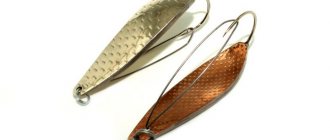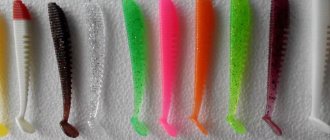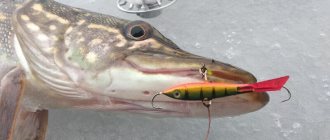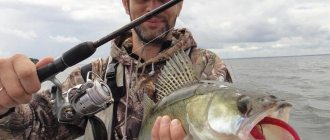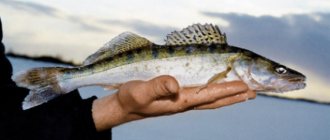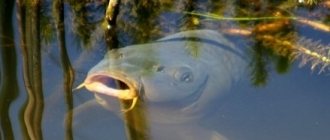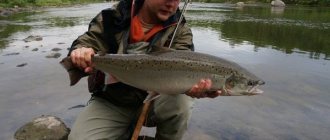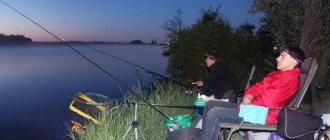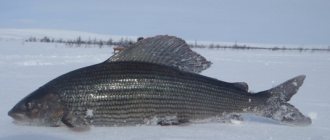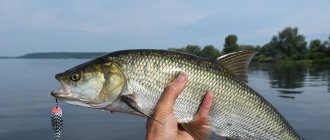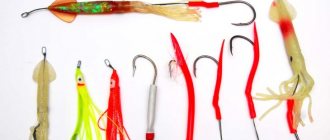The activity of the predator in winter varies due to changing conditions - it is highest during the first and last ice, weak or almost absent during the period of deep winter. It is about fishing for toothy fish in February - the month during which changes occur that mark the transition from deep winter to the time of last ice - that we will talk about in this article.
Choosing a fishing spot
Since there is a gradual change in weather during February, the increase in day length and air temperature of the pike's stopping place at the beginning of the month and at the end differs.
From the beginning to mid-February, when there are still severe frosts at night and sometimes during the day, pike prefers to stay in the following places:
- deep holes and pools;
- deep edges;
- flooded snag;
- the mouths of streams and rivers that flow into a larger river, pond, or lake.
At the end of the month, as the sun begins to melt the ice and snow on the banks of reservoirs and life-giving oxygen begins to flow into the reservoir with melted streams, the pike, following the small fish, leaves the depths and begins to hunt in places such as:
- coastal strip with shallow depths of up to 2-2.5 and thickets of dry reed and sedge;
- places where streams and rivers flow into a lake or pond;
- areas near various hydraulic structures - locks, dams, dams.
What to catch?
If at the beginning of winter fishing with live bait has neither result nor success, then February radically changes the situation - for its time this is the ideal method in combination with girders. A cunning fish, even if very hungry, will not react to artificial baits, bypassing spinners, twisters, and balancers. But it will rush to live bait without looking back. This option requires standard equipment of rigs (stand, reel, signal beacon), 0.5 mm fishing line, sinker and hook.
For bait, it is better to take small representatives of roach, perch, gobies or gudgeon; they are active and hardy, and can quickly attract the attention of pike.
Artificial baits, balancers and spinners will only come into use at the very beginning of the spring season, when the fish have warmed up and are well hungry. In the icy February waters, for successful fishing it is better to use bottom baits, heavy and large, 6 - 12 cm long. In fact, experienced fishermen advise taking a full arsenal of baits and other gear with you for February pike fishing, since it is impossible to say for sure what will work on a pike that has not yet recovered and is slightly dazed from the cold.
It is difficult to draw conclusions about the success of February fishing; it depends on many conditions and their implementation. We can say for sure that fishing at the end of the month along the coastline with live bait will be more successful.
TAGS:
Pike behavior in February
Just like in the summer, at the end of winter, in order to successfully catch pike in open water, you need to understand how the predator behaves in these conditions. Since February is a transition month between winter and spring, during which changes in weather and day length occur, the behavior of the toothy one also reacts sensitively to these changes:
- Depending on weather conditions , but, as a rule, until the middle of the month, pike, due to severe frosts and lack of oxygen dissolved in water, leads a fairly sedentary lifestyle - the “hunting” area that it patrols has a small water area, the prey at this time is a predator prefers no more than 10 cm, so as not to waste extra effort on swallowing and digesting it. Since at this time the pike’s metabolism is slow, a small amount of food is enough to satiate it, after which it falls into a stupor and digests the swallowed fish.
- At the end of the month, pike leaves the depths following small fish and approaches the shores , the confluence of streams and small rivulets, and the openings to dams, dams and sluices located along the shore - in these places, the influx of fresh water carries oxygen, thanks to which the predator becomes more active and on the eve of spawning begins to feed intensively. At this time, the pike is quite active and hunts much longer than at the beginning of the month.
In general, pike fishing in February differs little from pike fishing in January, with the only difference being that if severe frosts strike, the pike will actually stop leaving its camp site.
Fishing technique and tactics
Beginners often ask if pike can be caught in February. And the experienced ones know that it can be caught, and how. You just need to understand the characteristics of the reservoir and the behavior of the pike in it, take into account regional and weather nuances, apply the right tactics, equipment and gear, depending on the passivity or activity of the toothy fish.
Search
On small reservoirs, rivers and ponds, pike spots do not change for years. However, finding the toothy pirate in reservoirs can be problematic. The predator's stopping places here depend on migrations for spawning and the location of schools of forage fish. Where is the best place to catch pike in reservoirs in February? It is impossible to say exactly where pike live in February in reservoirs with constantly changing water levels. Every year the situation can change dramatically. But it is advisable to know the general trends:
- At the beginning of the month, the predator most likely stands in the usual “dead-winter” places - channel edges, slopes into pits, deep-sea snags and under underwater cliffs.
- In the middle of the month (earlier in some places, later in other places), the toothy can be found in a larger area of water; the predator begins to visit shallower water areas.
- On reservoirs with flat terrain or with a trough-shaped bottom along the entire length, the predator can be anywhere. Where there are forage fish. This may be a certain level of increasing depths from the shore or specific places - a bay, the mouth of a river, closer to a dam, etc. Each body of water has its own specifics.
- Closer to spring, the robber hunts closer to the shore, in shallow waters near the thickets. Following roach and other fish, it can accumulate in estuary bays or even enter tributaries. The estuary area is always a promising place. Shallow overgrown bays, spills when the water level rises.
- Sometimes, more likely this is already in the realm of March fishing, the pike stands at a minimum depth, literally twenty centimeters between the ice and the bottom. Such places also need to be checked.
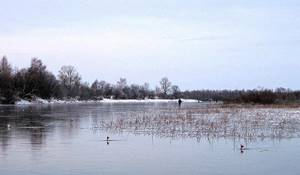
Where to look for pike in February on lakes? Depends on the characteristics of this reservoir. But the principle is the same - by spring we look near the shore, in the reeds. Trophy specimens most likely will not leave their deep snags, but may be rushed to spawn in nearby inflowing rivers.
Where to look for pike in February on the river? On small rivers in the same place as always. Searching on large ones is difficult, as well as on reservoirs. The main thing is to feel the spring trend and build on it.
Where to look for pike in February on a pond? Most likely, the predator was not caught in closed reservoirs all winter. With the beginning of melting and general warming, the fish in such reservoirs become more active and begin to feed intensively. You need to look for it in any promising places. Again, these are snags, bushes, any shelter suitable for ambush and hunting.
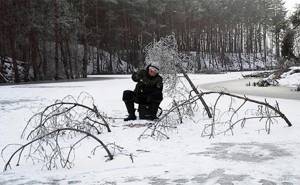
Fishing Features
The nuances of pike fishing in February are precisely determined by these swings - whether the predator is already active or not, whether it has run aground or is still standing in the holes, whether the toothy one has gone closer to spawning somewhere in the mouth bay or upstream. How to catch a pike in February if it has disappeared and its location has not yet been found? Search and try to catch. You can find a toothy one in an unobvious place.
The small grass usually wakes up first. You can find it in the coastal reeds the earliest. Large individuals sway for a long time and wake up slowly. When small fish are already actively responding to the lure in the coastal zone, the pike patriarchs are just beginning to crawl out of their possessions.
Disputes about fishing tactics, whether to hatch a predator or constantly look for a new place, will never subside. There is always intrigue in February toothfishing, and tomorrow’s fishing may be completely different from today.
Subscribe to the channel:
My YouTube channel RYBAFAN on fishing:
We're OK
Selection and equipment of the girder
The most popular and widespread equipment for pike fishing among winter fishermen is the winter girder (stave).
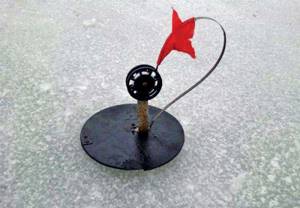
What it consists of:
- a bracket with a reel on which the equipment is wound;
- a signaling device made of a flat steel spring with a flag made of bright red fabric;
- a round-shaped stand with a central hole for the bracket, a slot for passing fishing line and a place - a small round protrusion with a slot-like hole - into which the alarm is inserted.
A simple diagram of the device of the vent
Of all the variety, this design is the most popular due to a number of advantages:
- takes up little space in the box during transportation;
- has high strength and reliability of all components;
- quickly and easily assembled on site;
- is highly resistant;
- protects the hole from rapid freezing.
The equipment of such a girder for pike fishing consists of:
- fishing line with a cross section of 0.3-0.4 mm and a length of 15-20 meters;
- sliding sinker of the “olive” type weighing from 5 to 10-15 grams;
- Thin tungsten leash 10-15 cm long;
- hook - triple or double - No. 4-6;
How to make a zherlitsa with your own hands
First, we recommend reading our guide to making 8 zherlits yourself!
Secondly, let's briefly go over the most important points.
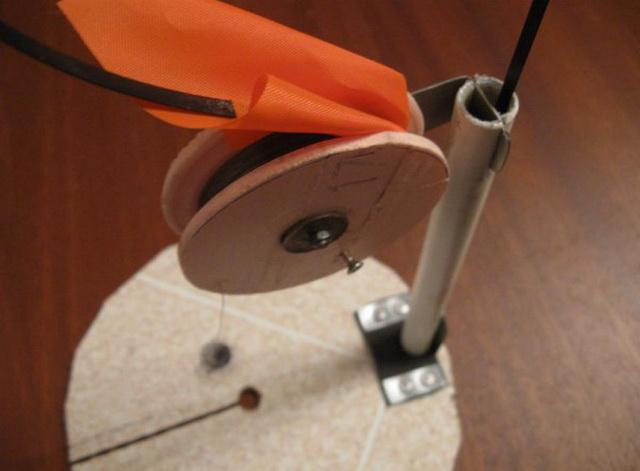
The entire manufacturing process is very simple and consists of a number of sequential operations:
- A rectangle measuring 10x20 cm is cut out of plywood 10-12 mm thick;
- In the middle of the resulting board, along the long side in the middle, draw a line with a thick marker;
- Two points are marked on the line with an indentation from the edge of 4 and 10 cm, respectively;
- A hole with a diameter of 6 mm is drilled at the first point, 10 mm at the second; also, on the edge opposite to the holes, a cut is made for the signaling flag using a jigsaw or a thin drill;
- The board is primed and painted with oil paint;
- An M6 bolt 40 mm long is inserted into the first hole. and on the reverse side clamp it with a nut
- Place a washer over the nut;
- A spool-reel with fishing line wound around it is placed on the bolt;
- The coil is fixed on top with two nuts so that it can rotate freely;
- A special hook similar to the letter “g” is screwed between the reel and the central hole so that it is flush with the plane of the reel - when fishing, the flag is bent and placed under this hook. When a pike grabs a live bait, the reel, turning, touches the flag of one of its handles and moving it a little to the side causes the spring, not held by the hook, to fly up, warning the angler about a bite.
- In order to finally equip the girder, the fishing line from the reel is passed into the central hole, then a sliding sinker, a rubber or silicone stopper is put on it, a leash is tied, and a double or triple hook is attached to the leash.
This homemade design is very easy to assemble and operate, has low windage, and fits compactly into a fishing box.
Other fishing methods
In addition to girders, in February pike fishing they also use all kinds of gear with artificial baits - spoons, balance beams, crabs.
On the crab
The crab is a fairly new, but already well-proven bait for catching pike on a spinning rod, invented by Far Eastern fishermen.
The crab consists of:
- bodies of elongated, purulent, or triangular shape. The belly of the bait, often called the sole, can be either flat or concave or convex.
- 4-6 single hooks soldered in the head, tail of the body and on the sides;
- suspension (loop) for fastening the fishing line located in the middle of the body of the bait on its dorsal part.
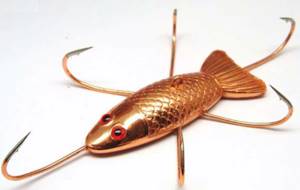
Heavy, flat-bellied baits with a length of more than 60 mm and a weight of 30-40 grams are suitable for catching pike.
How to catch?
- the bait is carefully lowered into the hole and allowed to fall freely until it reaches the bottom;
- then, by rotating the reel, the “crab” is raised above the bottom by 5-10 cm;
- perform a smooth lifting of the bait with a fishing rod to a height of 25-30 cm;
- after a smooth rise, the bait is allowed to fall sharply under its own weight to the starting point;
- pause for 5-7 seconds;
- perform a new climb.
Such a heavy and voluminous bait is used when fishing for pike with a spinning rod at large and medium depths, as well as in the current.
Lure fishing
The spinner is the first artificial bait that was used to catch pike.
Pike are caught with spinners throughout the ice fishing season, more productively on the first and last ice, but predators often catch this bait even in the dead of winter.

In February, as pike activity increases, use the following lures:
- Heavy oscillating summer spoons
- Special vertical and bottom winter lures
The length of baits when fishing for pike should be more than 6-7 cm in order to exclude bites from small and medium-sized perch.
The best models of spinners:
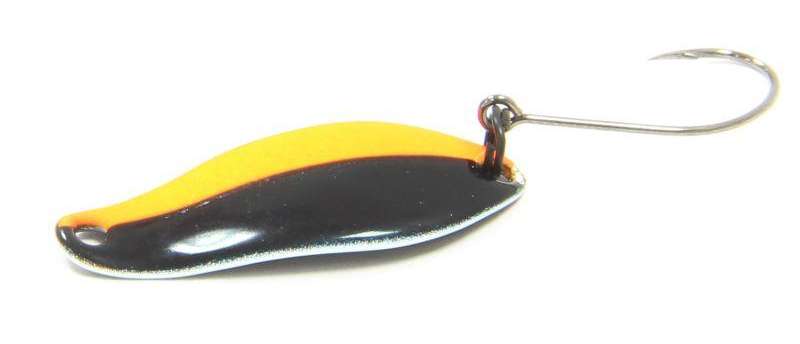
Atom 2
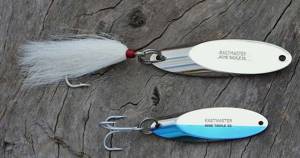
Castmaster
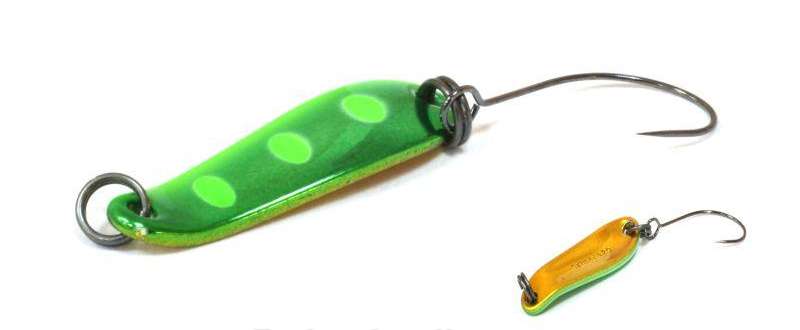
Spoon
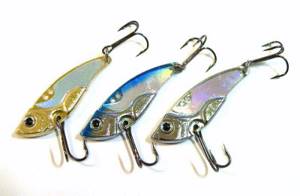
Cicadas
The game of lure fishing consists of a number of repeated actions:
- Having lowered the bait to the bottom, by winding the reel or using a fishing rod, raise it above it to a height of 4-6 cm;
- perform a smooth rise 30-40 cm from the starting point;
- allow the bait to fall to its original (starting) position above the bottom under the influence of its weight, without slowing down its movement;
- wait some time (3-5 seconds) until the spoon stops all movements and perform the next lift again.
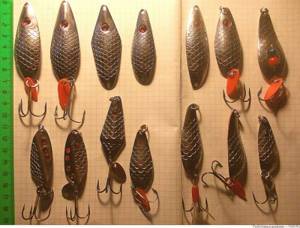
When the bite is weak, some spinners make several lifts of the spoon, during which they let it fall to the very bottom - this technique is called “knocking on the bottom” and contributes to the formation of a fairly clearly visible cloud of turbidity, inside which a moving object periodically appears, attracting the attention of the pike.
To the balancer
Along with perch, pike can also be successfully caught with this bait. However, the balancers used for toothy ones are large in size - the most universal baits of this type are 9-11 cm long (No. 9 and No. 11).
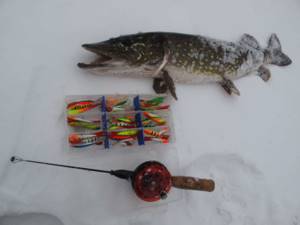
Pike are caught with this bait in February in deep holes, deep edges, near the mouths of rivers and streams.
The technique of playing with pike balancers, in contrast to small perch ones, is somewhat different:
- the bait, lowered to the bottom, is raised 5-10 cm above it by winding the fishing line with a reel;
- lifts with a balancer are made to a height of 25-30 cm above the bottom, alternating sharp throws with smoother lifts;
- pauses between lifts last from 3 to 5 seconds.
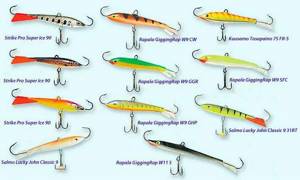
In the absence of bites, the predator is attracted by a game consisting of smooth non-stop rises to a large (up to 50 cm) height - the balancers with such a game are visible from afar and well attract a passive pike standing nearby.
Fishing for pike in January using a spinning rod

Therefore, many fishing enthusiasts do not want to give up their hobby - fishing for pike with a spinning rod in January, and for this they go to ice-free reservoirs. In the middle of winter, many outings remain unsuccessful, but it also happens that you manage to take trophy specimens of pike with a spinning rod. This is interesting: The best lures for pike when fishing with a spinning rod
Where to look for pike in January
Although in January the toothy predator does not move much around the reservoir, there is still such a dependence: in severe frosts it is more often caught in deep places away from the shore, and with the onset of a thaw, the pike often goes out into shallow water, as if rehearsing its future spawning behavior .
Anglers who practice spinning fishing in January use vibrating tails and twisters, but don’t forget the rule that there are almost no baits that don’t work at all, today you can catch only with a twister, tomorrow with a spoon, the day after tomorrow with a spinner, on some day No matter what you tempt the predator, it won’t bite. In January, pike hunt more for small fish; baits should not be large either.
Posting bait in January
The January pike behaves even more “inhibited” than in December, so the bait should be retrieved very slowly, the retrieve step is one or two turns of the spinning reel, the pause can be three or four seconds. You shouldn’t speed up the pace of the retrieve, even if your nerves can’t stand it from the huge number of “idle” casts.
Watching January pike with a spinning rod in the thaw video
There's a thaw in mid-January and we immediately rush to the DWR to indulge our souls in spinning.
Pike on microjig. Winter spinning in January video
Fishing sequence
When fishing for pike in February, a fairly effective and simple fishing technique is used, consisting of finding a place, drilling holes and catching them.
Fishing technique
- Search for a promising place - using a depth gauge or echo sounder, they find an area with great depth, a sharp drop (before the middle of the month), shallow areas, watering (at the end of the month).
- Drilling holes - holes are drilled in the selected area in increments of 10-15 meters. When drilling a hole, especially at a depth of up to 1 m, it is better not to “pump” it (clean it with sharp movements, lowering the ice pick into the drilled hole and pulling it out with an auger clogged with slush) - this will not only not create unnecessary noise, but will also obscure the hole.
- The order of fishing holes - fishing begins with the holes drilled first, 10-15 lifts are performed in each of them, and if there are no bites, they move to the next one. If a pike is caught in a hole, they mark it with a twig or branch and move on to the next one in order to return to it after a while - the place of the caught pike, as a rule, is taken by another.
If there were no bites on the drilled holes, change the playing technique, performing lifts more smoothly, changing the pause time. It is also necessary to change bait periodically.
Peculiarities
In February pike fishing there are several features characteristic of this month that must be remembered and, if possible, used when fishing:
- The pike bite until the middle - the beginning of the second ten days of the month is not very active - the predator feeds no more than half an hour a day, so it is very important to find out from local fishermen what time the toothy fish most often comes out to feed and place bets in advance or make holes and start catching them their artificial baits.
- We recommend small crucian carp as live bait at this time - unlike perch and roach, it remains alive longer and is not very susceptible to changes in atmospheric pressure.
- From the middle of the month, pike, preparing for spawning, begins to move from holes to shallow waters, where they feed longer and more actively, so in the second half of February the predator should be caught in the coastal zone, in shallow bays and backwaters.
- The universal places for predator fishing throughout February are the mouths of streams and rivers, places where springs gush out - in such places there is much more oxygen than in other parts of the reservoir, which attracts small fish, and after them pike.
Important. When moving on the last ice, especially near the mouths of streams and rivers, near locks, use an ice pick to check the reliability of the ice.
How it happens
And the next morning it started to snow and visibility became minimal. It's good that there is such a thing as a navigator. Almost by touch, we rode snowmobiles to the points filled with our friends throughout this week.
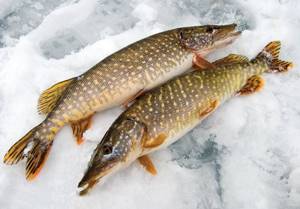
And what? Not a poke. That is, nothing at all, not a single bite. The predator flatly refused to take our spinners, balance beams, winter wobblers and other clever baits seriously.
Saturday passed in vain searches, followed by Sunday. In the evening we began to get ready to go home, watching during the loading process how our reconnaissance team loaded dozens of frozen pike carcasses into their trailer. Of course, friends shared fish with us. But the whole mood was hopelessly spoiled. This is the kind of pike fishing that happened to us in February.
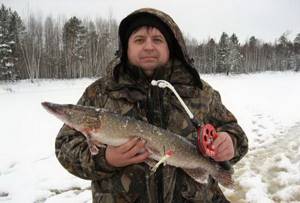
Therefore, I repeat to you once again - pike fishing in February, in this capricious winter month, should be planned for stable, without fractures, weather. But the work can wait.
More on this topic on our website:
- Pike fishing in November on the first ice Where the first ice has already formed, pike can be successfully caught using winter bait in early November. Fishing boats are laid up...
- What to do if the pike doesn’t bite - time and place When going to a pond, every angler, be it a floater or a spinning angler, hopes for a decent fish bite. Arriving at the reservoir and appreciating...
- Pike fishing calendar I may fish, or I may not. Every experienced fisherman can say this, because over time he accumulates fishing experience...
- How to catch pike in bad weather - the ideal option To understand how to catch pike in bad weather, you don’t need to study hundreds of smart books or watch all the TV shows on...
Important Tips
- The snag found using an echo sounder is drilled from all sides and fished as close to it as possible. Since in such places there is a high probability of snagging, they use non-snagging spinners, and in extreme cases, unhooking.
- On an unfamiliar body of water, promising places for pike fishing can be found by the concentration of local anglers. The main thing is to follow the rules of unwritten fishing ethics - holes should be drilled from the exposed girders at a distance of at least 10 meters, it is better not to walk near the stakes;
- When using light baits, in order not to “pump” the hole with a drill, the following technique is used to most completely clear it of slush: when drilling the first hole, count the revolutions, on the next hole, during its drilling, the drill is taken out several times along with the resulting ice crumbs, and in 2 turn to the end, select the remaining sludge and, having drilled a hole, completely clean out the ice crumbs with a ladle.
- When fishing with artificial baits - balancers, spoons, crabs - we recommend rigid and durable fishing rods made of composite or fiberglass. The nod is used when fishing with spinners weighing up to 8 g; in other cases, heavy baits can be felt very well by the hand. The rod of the fishing rod must be rigid and strong, otherwise, when hooking, the hook will either jump out of the pike’s mouth or pierce it and be caught in it very weakly, leaving the fish with a huge chance to get off when fishing.
- When fishing for pike with artificial bait, it is necessary to use a metal leash - although it worsens the quality of the game, it also eliminates the risk that the pike will get off when fishing, “cutting off” the bait;
- In order to most objectively assess the reaction to a bait moving in the water column, it is better to use an echo sounder-flasher or an underwater camera - they allow you to clearly see how interesting a particular bait is to a predator, how it reacts to a game of different speeds.
Conclusion
It’s difficult to catch a pike in the middle of nowhere; you need to clearly know where it’s staying and when it’s going to go out for a short hunt. To obtain such information, it is better to experimentally study the reservoir. Information received from local fishermen will also be relevant. A fairly important addition is the use of modern technologies: latest generation echo sounders, underwater video cameras that transmit information to the fisherman’s phone. Thus, it becomes possible to use the most reliable information, which will significantly increase the efficiency of all fishing. The last week of February is especially interesting for predator hunters; at this time, significant catches can be achieved, including the possible capture of trophy specimens.
The video will tell you about catching pike on girders in February:
